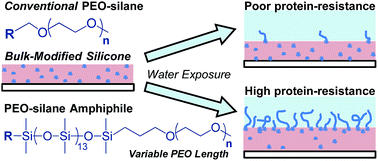Enhancing the protein resistance of silicone via surface-restructuring PEO–silane amphiphiles with variable PEO length†
Abstract
Silicones with superior protein resistance were produced by bulk-modification with poly(ethylene oxide) (PEO)–silane amphiphiles that demonstrated a higher capacity to restructure to the surface–water interface versus conventional non-amphiphilic PEO–silanes. The PEO–silane amphiphiles were prepared with a single siloxane tether length but variable PEO segment lengths: α-(EtO)3Si(CH2)2-oligodimethylsiloxane13-block-poly(ethylene oxide)n-OCH3 (n = 3, 8, and 16). Conventional PEO–silane analogues (n = 3, 8, and 16) as well as a siloxane tether-silane (i.e. no PEO segment) were prepared as controls. When surface-grafted onto silicon wafer, PEO–silane amphiphiles produced surfaces that were more hydrophobic and thus more adherent towards fibrinogen versus the corresponding PEO–silane. However, when blended into a silicone, PEO–silane amphiphiles exhibited rapid restructuring to the surface–water interface and excellent protein resistance whereas the PEO–silanes did not. Silicones modified with PEO–silane amphiphiles of PEO segment lengths n = 8 and 16 achieved the highest protein resistance.


 Please wait while we load your content...
Please wait while we load your content...